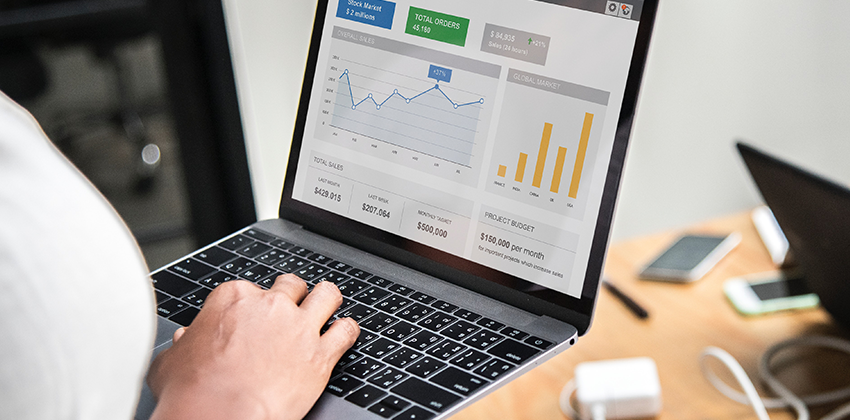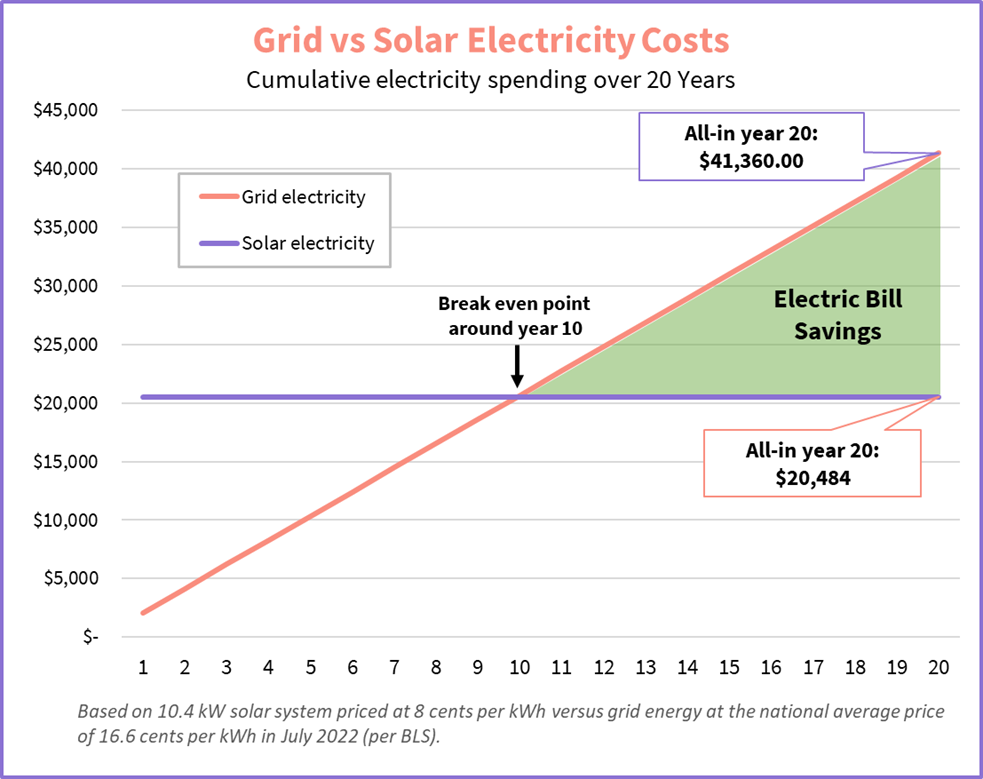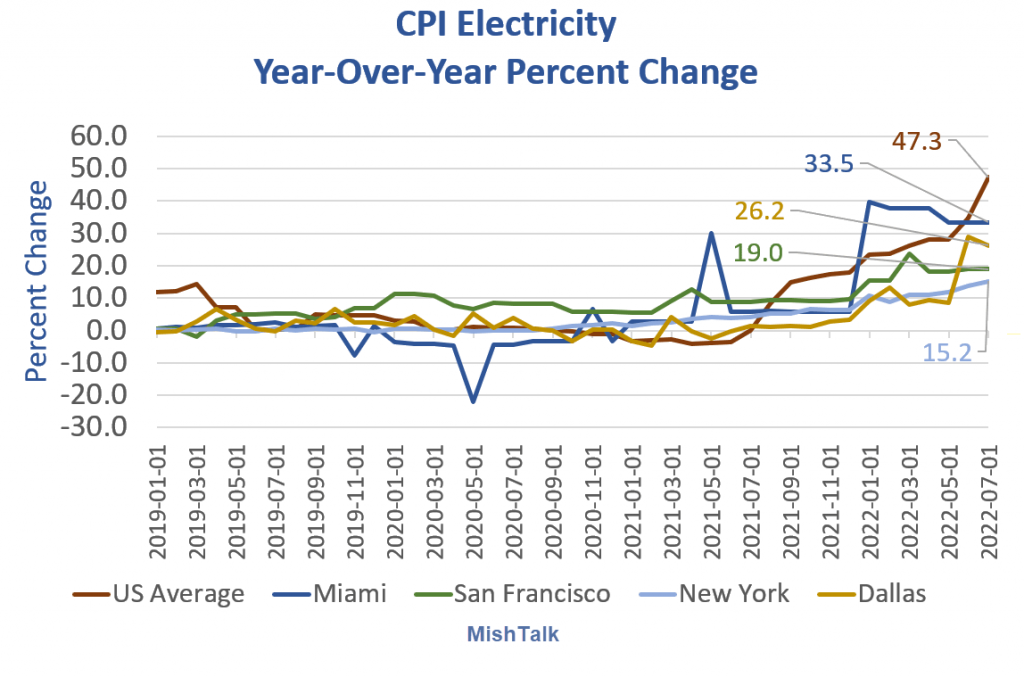See how much solar panels cost in your area

Please enter a valid zip code.
Zero Upfront Cost
Best Price Guaranteed
![]()
![]()
Solar Learning Center > The Pros and Cons of Rooftop Solar in 2025 > How Do Solar Panels Lower Your Electric Bill? > Page 3
How Do Solar Panels Lower Your Electric Bill?

We need electricity for everything from air conditioning and kitchen appliances to TVs and cell phones, and all of that usage adds up. But did you know you can use solar panels to lower your electric bill?
By fixing your electricity costs at a low rate, solar systems are often the best way of reducing your electricity bill without making drastic cuts to your energy usage.
In this article, we’ll explore how to use solar panels to lower your utility bill and give you the tools to start saving.
Ready to go solar? Get binding quotes here.
How to Lower Your Electric Bill With Solar Panels
To begin, let’s identify the three primary problems with electric bills:
- They’re expensive
- They’re continually getting more expensive
- They’re unpredictable
We’ll go over each problem, and show how solar is a solution to fix it and lower your electric bill.
Electric Bills Are Expensive
It may not feel like it, but your probably paying way more for grid energy than you would be for solar.
The price of electricity is measured in cents per kilowatt-hour (kWh). According to the US Bureau of Labor Statistics, the national average price for electricity in June 2023 was $0.17 per kWh.
Meanwhile, with the 30% federal solar tax credit available nationwide, the average price of electricity produced by solar systems purchased through solar.com is between typically around $0.08 per kWh.
That’s less than half of the national average and nearly four times less than the price of grid electricity in California. It’s even lower than the price in Washington State, where electricity is dirt cheap!
Related reading: Pros and Cons of Going Solar
Do solar panels lower your electric bill?
Solar panels can not only lower your electric bill — they can completely replace it.
Your electric bill depends primarily on two factors:
- How much electricity you use
- The rate at which the utility company charges for that electricity
If you’re stuck on grid power, there’s almost nothing you can do to lower your rate. So, you’re left with trying to lower your usage by putting a lock on the thermostat and using a binoculars to watch Netflix through your neighbor’s window.
But by using solar panels, you can lower your electric bill by slashing the rate to around 8 cents per kWh — far lower than the price per kWh in any major US metro.
Think of going solar as replacing your electricity bill with monthly payments for your solar equipment. Here’s how that looks over 20 years of paying 8 cents/kWh for a cash solar purchase versus the national average 16.6 cents/kWh for grid energy.
Home solar versus grid electricity

In this scenario, the grid user paid $41,360 for 20 years of electricity, while the solar owner paid $20,484 for 20 years of electricity.
All-in, using solar panels lowered the cumulative electricity bill by $20,876 over 20 years. And the overall savings could be more than that for three reasons:
- Most solar equipment is warrantied for 25 years and lasts much longer than that
- Solar panels increase your home value
- Grid electricity rates increase over time
Grid Electricity Rates Are Always Rising
Grid electricity rates are already higher than solar, and they will continue to increase over time. By taking these rate hikes into account, solar panels can lower your electric bill even further.
In the last 20 years, the price of grid energy has increased 2.79% per year on average, according to the Bureau of Labor Statistics. But in 2022, the average rate increased 12.6% in one year!

That’s a major shock to the system, and the EIA is projecting another above average rate increase of 3.77% from 2022 to 2023.
In the big picture, utility rate increases are the rule — not the exception to the rule. In fact, the average price of grid electricity has increased in 31 of the last 40 years.

Meanwhile, going solar fixes your electricity costs for the lifetime of the system. So, if you go solar in 2023 at 8 cents per kWh, you’ll still essentially be paying 8 cents per kWh in 2043 when grid energy is over 28 cents per kWh (based on 2.79% increase per year — it could be more!).
Here’s how paying for solar versus grid electricity looks over 20 years when accounting for 2.79% rate hikes based on the historical average and 5% rate hikes that are more in line the average rate of inflation.
Home solar versus grid electricity with rate hikes

Taking rate hikes into consideration, solar owners would save:
- $33,912.50 over 20 years of 2.79% annual rate hikes
- $47896.39 over 20 years of 5% annual rate hikes
How much will the price of grid electricity go up over the next 20 years? Nobody knows, but it’s clear that solar is the cheaper bet over the long haul.
Why do utilities hike electricity rates?
Even as utilities add cleaner, cheaper renewable energy into the electric grid, they face enormous costs to maintain and expand the grid.
Since the US was one of the first countries to build out an electric grid, it also means that our system is one of the oldest. Utility companies spend hundreds of millions of dollars every year upgrading their towers, lines, substations, and transformers. These costs continue to drive up the cost of delivering electricity, even as cheaper generation sources come online.
Homeowners can lower electric bills with a solar power system. Solar systems have almost no ongoing fuel or maintenance costs – sunshine is free! Solar systems also produce power right where it’s needed (in the home), which avoids costly transmission infrastructure.
As grid maintenance costs continue to rise, solar systems will provide increasingly attractive returns.
Electric Bills Are Unpredictable
In the last section we used nice, steady rate hikes to show how grid electricity increases over time. But in reality, grid electricity rates are anything but steady.
Take a look at this graph of year-over-year electricity price changes since 2019 from MishTalk.

See a pattern? We don’t either. It’s madness.
But here’s the takeaway: The average American paid 47.3% more for grid electricity in July 2022 than they did in July 2021.
Few people, if any, saw that coming.
It’s also hard to predict where utility rate hikes will strike next. The map below shows the rise in utility rates from April 2022-April 2023 for each state, which ranged from 33% in New Hampshire to -7% in Louisiana.
Skip the guessing game with solar
With solar, energy costs are extremely predictable.
Many homeowners are able to cover 100% of their energy needs with their solar system, in which case they will typically only have a $10-20 minimum service charge from the utility that goes towards grid maintenance fees, charges for net metering, and other associated costs.
If the solar system doesn’t cover 100% of their needs, then they will have some level of remaining electric bill that will vary through the year.
With a cash purchase, there’s no recurring cost for the system or power. With financing, there’s a set monthly payment that doesn’t vary based on season or immediate usage. Either way, this stability can be very valuable for homeowners budgeting their monthly expenses.
Lower your electric bill with solar panels
To recap, solar panels do two things to reduce your electric bill:
- They set the price you pay for electricity lower than what you would pay on the grid (~8 cents per kWh for solar versus the national average 16.6 cents per kWh for grid)
- They shield you from the ever-rising cost of grid electricity
In addition, solar panels also increase your home value, reduce your carbon emissions, and bring stability to your electricity costs.
Related Articles
Con Edison Electricity Rates Are Rising – Here’s How Solar Can Help
Con Edison, a major utility company serving New York City and Westchester County, has proposed substantial electricity rate increases set to take effect on January...
Will Electricity Prices Go Down in 2025?
After a rapid increase in utility rates in 2022, many homeowners are feeling the pain of several years of high electricity bills and wondering if...
What's the Average Electric Bill for a 3 Bedroom House?
The average electric bill for a 3-bedroom house — or any house, for that matter — has increased substantially over the last few years several...
What’s the Average Electricity Bill for a 2 Person Household in 2025?
Electricity bills have increased substantially in recent years due to rising utility electricity costs and extreme weather events that require more consumption for heating and...
2024 SCE Time-Of-Use (TOU) Rates: A Beginner's Guide
Electricity is an essential good that we all pay for one way or another. In Southern California, unless you have solar panels, you’re likely buying...
Con Edison Electric Rates in 2024: Plans, Rate Hikes, and Lowering Your...
Electricity is something we’re all going to pay for – one way or another – throughout our lives. And while it’s easy to put utility...
Should CA Solar Owners Be Worried About Income Based Electricity Bills?
Update Feb. 1, 2024: A group of state lawmakers are introducing legislation to roll back Assembly Bill 205, which mandated income-based utility rates in California....
PG&E Electric Rates in 2024: How to Lower Your Essential Electricity Costs
Serving over 5 million households in California, Pacific Gas & Electric (PG&E) is the largest investor-owned utility in the US. As such, when PG&E raises...
2024 SDG&E Electric Rates: How To Lower Your Electricity Costs in San...
San Diego is known for its pristine beaches, world-class zoo, and some of the highest electricity prices in the world. In fact, if San Diego...
What's The Average Electric Bill in 2025 And How Does Yours Compare?
In the 21st century, electricity is an essential cost of living that we’re all going to pay for, one way or another. Yet it’s common...
How Much Is The Average Electric Bill in California?
The average electric bill in California is $170 per month, based on a statewide average monthly electric usage of 571 kilowatt-hours (kWh) per month and...
Understanding Your Electric Bill Before and After Going Solar
Energy cost savings is often the primary reason homeowners invest in solar panels. But what exactly happens to your electric bill before and after installing...
Why Is My Electric Bill So High With Solar Panels?
There are two reasons why your electric bill could be high with solar panels. First, your panels may not be producing enough electricity during the...
How Do You Calculate The Number of Panels on a 16 kW...
There’s something exciting about putting a nice round number on the amount of solar panels you need. The number of kilowatts in a solar system...
What Is the Average Monthly Electric Bill With Solar Panels?
With utility rates rising and household electricity usage increasing, many homeowners are looking for a way to lower their electricity bills (without turning their house...
What Uses the Most Electricity in a Home?
Between rising electricity prices and increasing consumption, Americans are facing some of the highest electricity bills of their lives in 2023. When those high bills...
How To Cut Your Electric Bill by 75 Percent
There are plenty of articles that claim you can cobble together “6 energy savings tips” or “use one magic device” to cut your electric bill...
How Much Does Electricity Cost in Your State?
Like running water, the price of electricity is something we don’t typically worry about until after a high electricity bill arrives. But understanding how much...
How Many kWh per Day Is Normal?
Homeowners across the US are receiving the highest electricity bills of their lives (so far), thanks to a combination of rapid utility rate hikes and...
How To Lower Your Electric Bill With Solar Panels
There are a zillion articles and videos promising “expert tips” for how to lower your electric bill. Spoiler alert: 99% of them focus solely on...
Why Is My Electricity Bill So High?
When it comes to paying for electricity, most households are battling a two-headed monster. One of the heads is usage. We are using more and...
5 Reasons Solar Panels Are Worth It in Boston
New England may not jump out as a premier place for solar energy, but with robust incentives and some of the nation’s highest electricity prices,...
Is Solar Still Worth It With NEM 3.0 in California? 5 Ways...
With the NEM 3.0 solar billing policy in place for California’s three largest utilities, many homeowners are wondering if home solar is still worth it...
6 Reasons You Should Buy Solar Panels
There is a lot of buzz around home solar these days. There are a lot of messages pushed to homeowners about their options. I’d like...
Top Reasons Why You Should Go Solar Before 2022
Have you been wondering whether you should take the leap over to solar before 2022? Some reasons for doing so are obvious, such as cleaning...
The Top 5 Reasons To Go Solar in 2021
America’s revolutionary solar advocate succinctly summarized the reasons why you should go solar. I’d put my money on the sun and solar energy. What a...
The Impact of SCE’s Rate Changes
At the beginning of 2020, SCE (Southern California Edison) released updated electricity rates for customers who go solar. Generally speaking, when utilities change their rates,...
San Diego Gas and Electric (SDG&E) proposes a 28% rate hike over...
San Diego and Southern Orange County energy provider, San Diego Gas and Electric (SDG&E), is proposing a 28% rate hike over four years. The biggest...
PG&E Raised Prices 4% Annually on Average to Discourage High Users
California’s largest utility, Pacific Gas and Electric Co (PG&E), is making strides towards limiting energy use, simplifying rate plans, and promoting clean energy. Unfortunately,...
Here's How to Understand Your PG&E Bill After Going Solar
For residents of California who are customers of the Pacific Gas & Electric (PG&E) company, one of your biggest questions before you decide to switch...
A History of Con Edison's Electricity Rates
It is no secret that the cost of electricity has been going up recently and is set to increase further in the future. All throughout...
SoCal Edison Electricity Rates Increase in 2018 & 2019
It’s common knowledge that the cost of solar panels and other solar related technologies has dropped significantly over the past decade and will continue to...
Your Life Once You Go Solar
If you landed on this post, then you probably have some interest in going solar. Maybe you have already installed a solar panel system and...
The Top 10 Benefits of Switching to Solar
For most people, making the decision to go solar brings up many questions. Even just thinking about switching to solar energy can sound strenuous. However,...
10 Tips To Lower Your Electric Bill
At Solar.com, our team is always looking out for ways to save you money on your electric bill. Here are 10 tips to help you...
Northern California's Electricity Rates Jumped 21% in 2016
Northern California’s Recent Rate Hikes Northern California homeowners are irate after their electric bills jumped over 21% in 2016. The biggest hike came in August...
PUC Decision May Signal Demise of Nevada Solar
The Nevada Power and Utilities Commission recently weighed in on the state’s net metering debate with bad news for solar customers and the solar industry...
Outrage over NV Energy "Bait and Switch"
NV Energy’s newly implemented solar price increase has been met with disbelief and outrage. Just days ago, two NV Energy solar customers filed a lawsuit...
Salt River Project Rate Hikes Threaten Arizona Solar Viability
With scorching temperatures and nearly year-round sunshine, Arizona seems to be an ideal location to implement a rooftop PV system. However, with the possibility of...
Wind Power vs. Solar Power
In 2014, 369.6 GW of energy was generated from wind power globally. This number continues to grow every year, and it shows no signs...
See how much solar panels cost in your area.

Please enter a valid zip code.

Please enter a valid zip code.
Zero Upfront Cost. Best Price Guaranteed.





